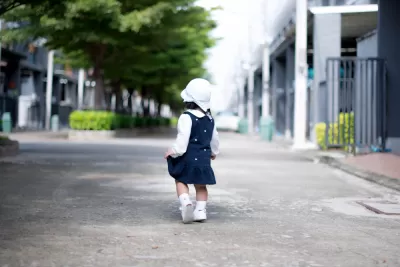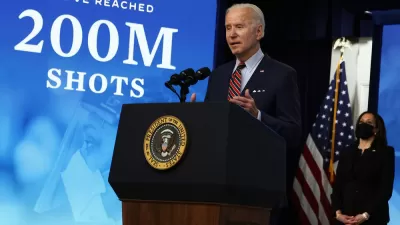A TV show featuring young Japanese children going on errands on their own highlights the differences between Japanese and American urban design that enable even toddlers to safely navigate big cities.

Henry Grabar comments on the urban design differences that enable Hajimete no otsukai, a long-running Japanese television show that follows toddlers in big cities going on errands alone (followed by a camera crew, of course). “In the first of the 20 episodes made available to Netflix subscribers, a 2-year-old travels to the town convenience store to buy groceries for Mom. In the fourth, 3-year-old Yuka crosses a five-lane road in Akashi, a city the size of Cincinnati, to get to the fish market.”
“But the Japanese are not so different from us,” Grabar writes. “They’ve just made policy choices that make it possible for kids to run their first errand a decade before their American counterparts get to do the same.”
Typically, Japanese children don’t actually run errands for Mom and Dad in the city at 2 or 3 years old, [Hironori Kato, professor of transportation planning at the University of Tokyo] notes, as they do in the show. But the comic, TV-friendly premise exaggerates a truth about Japanese society: Children in Japan have an unusual degree of independence from an early age.
Grabar attributes this independence to several factors: “Drivers in Japan are taught to yield to pedestrians. Speed limits are low. Neighborhoods have small blocks with lots of intersections.” Additionally, “Many small streets do not have raised sidewalks but depend on pedestrians, cyclists, and drivers to share the road. Curbside parking is rare, which creates better visibility for drivers and pedestrians and helps give the smaller streets of big Japanese cities their distinctive feel.”
Rebecca Clements, a research fellow at the University of Sydney, says “the show is evidence of how Japan gives children a ‘right to the city.’” E. Owen Waygood, a professor at Montréal Polytechnique, says the culture of independence doesn’t only liberate children: “Japanese kids ages 10 and 11, Waygood found, make just 15 percent of weekday trips with a parent, compared with 65 percent of trips for American kids. A city that frees children also frees their parents.”
FULL STORY: How Japan Built Cities Where You Could Send Your Toddler On An Errand

Alabama: Trump Terminates Settlements for Black Communities Harmed By Raw Sewage
Trump deemed the landmark civil rights agreement “illegal DEI and environmental justice policy.”

Planetizen Federal Action Tracker
A weekly monitor of how Trump’s orders and actions are impacting planners and planning in America.

The 120 Year Old Tiny Home Villages That Sheltered San Francisco’s Earthquake Refugees
More than a century ago, San Francisco mobilized to house thousands of residents displaced by the 1906 earthquake. Could their strategy offer a model for the present?

Opinion: California’s SB 79 Would Improve Housing Affordability and Transit Access
A proposed bill would legalize transit-oriented development statewide.

Record Temperatures Prompt Push for Environmental Justice Bills
Nevada legislators are proposing laws that would mandate heat mitigation measures to protect residents from the impacts of extreme heat.

Downtown Pittsburgh Set to Gain 1,300 New Housing Units
Pittsburgh’s office buildings, many of which date back to the early 20th century, are prime candidates for conversion to housing.
Urban Design for Planners 1: Software Tools
This six-course series explores essential urban design concepts using open source software and equips planners with the tools they need to participate fully in the urban design process.
Planning for Universal Design
Learn the tools for implementing Universal Design in planning regulations.
Clanton & Associates, Inc.
Jessamine County Fiscal Court
Institute for Housing and Urban Development Studies (IHS)
City of Grandview
Harvard GSD Executive Education
Toledo-Lucas County Plan Commissions
Salt Lake City
NYU Wagner Graduate School of Public Service





























